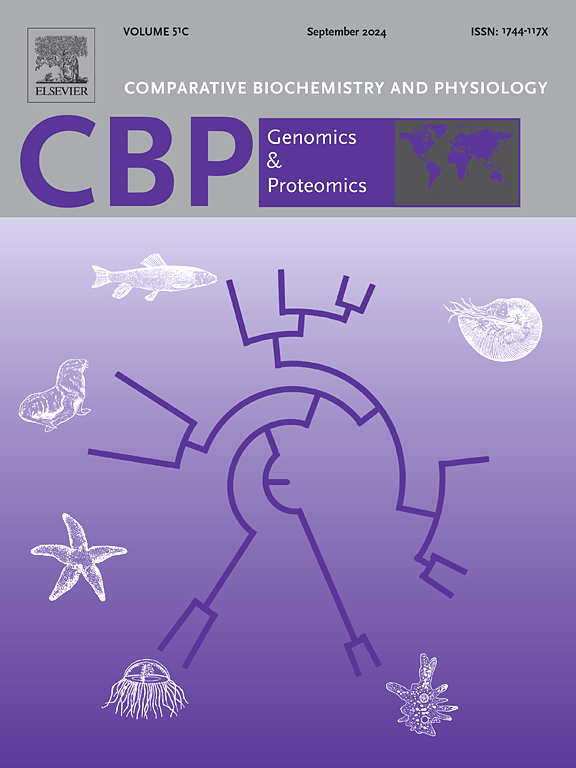Urechis unicinctus(Annelida,Echiura)中 TRAF 家族基因的全基因组鉴定及其在抗高温胁迫中的反应
IF 2.2
2区 生物学
Q4 BIOCHEMISTRY & MOLECULAR BIOLOGY
Comparative Biochemistry and Physiology D-Genomics & Proteomics
Pub Date : 2025-04-18
DOI:10.1016/j.cbd.2025.101516
引用次数: 0
摘要
肿瘤坏死因子受体相关因子(Tumor necrosis factor receptor-associated factors, TRAFs)作为重要的信号介质,在机体免疫和环境应激的生物反应中起着至关重要的作用。温度是生物生存的重要环境因子,但迄今为止,对海洋动物TRAF家族基因序列特征及其对高温胁迫响应的研究非常有限。在本研究中,我们对沿海经济穴居蠕虫乌丘兰(Urechis unicinctus)的TRAF家族基因进行了全基因组分析,揭示了它们对高温胁迫的响应特征。通过系统发育分析,从unicinctus基因组数据库中鉴定出9个TRAF序列,分别为UuTRAF2、UuTRAF3a、UuTRAF3b、UuTRAF3c、UuTRAF4a、UuTRAF4b、UuTRAF4c、UuTRAF6和UuTRAF7,共5个TRAF成员。特别值得一提的是,与其他无脊椎动物相比,美国独角兽的TRAF3和TRAF4拷贝数更高,而TRAF2和TRAF3内含子的长度和数量明显更短、更少。此外,TRAF家族基因在unicincus的胚胎、幼虫和成虫组织中的表达具有明显的时空特异性,其中TRAF家族基因在幼虫、体壁和后肠中的表达量较多。在高温胁迫下(29°C),所有utrafs均显著上调,其中utraf2和utraf3a在实验阶段保持较高水平,说明其在高温胁迫下的重要作用。本研究结果将有助于进一步了解环节动物TRAF家族基因的序列特征,并为今后探索unicucus耐高温遗传机制和选育提供必要的数据。本文章由计算机程序翻译,如有差异,请以英文原文为准。

Genome-wide identification of TRAF family genes in Urechis unicinctus (Annelida, Echiura) and their responses in resistance to high temperature stress
TRAFs (Tumor necrosis factor receptor-associated factors), serving as important signaling mediators, are essential for organismal immunity and biological responses to environmental stress. Temperature is an important environmental factor for the survival of organisms, but so far, the studies on sequence characteristics of the TRAF family genes and their responses to high temperature stress in marine animals are very limited. In this study, we conducted a genome-wide analysis of the TRAF family genes and revealed their characteristics of responding to high temperature stress in Urechis unicinctus, an economic coastal burrowing Echuran worm. Nine TRAF sequences were identified based on U. unicinctus genome database, which belonged to 5 TRAF members by phylogenetic analysis, namely UuTRAF2, UuTRAF3a, UuTRAF3b, UuTRAF3c, UuTRAF4a, UuTRAF4b, UuTRAF4c, UuTRAF6 and UuTRAF7. Especially, the copy number of TRAF3 and TRAF4 was higher, while the length and number of introns in TRAF2 and TRAF3 were significantly shorter and fewer in U. unicinctus compared to other invertebrates. Furthermore, the expression of the TRAF family genes showed obvious spatio-temporal specificity in the embryos, larvae, and adult tissues of U. unicinctus, with more TRAF family genes expressed in larvae, body wall, and hind-gut. When U. unicinctus adults were stressed by high temperature (29 °C), all the UuTRAFs were significantly up-regulated, especially UuTRAF2 and UuTRAF3a, which were kept at high levels during the experimental phase, indicating their importance in responding to the high temperature stress. Our findings will facilitate a greater comprehension of the sequence characteristics of TRAF family genes in annelids, and provide essential data for future exploring the genetic mechanism and breeding of high temperature tolerance of U. unicinctus.
求助全文
通过发布文献求助,成功后即可免费获取论文全文。
去求助
来源期刊
CiteScore
5.10
自引率
3.30%
发文量
69
审稿时长
33 days
期刊介绍:
Comparative Biochemistry & Physiology (CBP) publishes papers in comparative, environmental and evolutionary physiology.
Part D: Genomics and Proteomics (CBPD), focuses on “omics” approaches to physiology, including comparative and functional genomics, metagenomics, transcriptomics, proteomics, metabolomics, and lipidomics. Most studies employ “omics” and/or system biology to test specific hypotheses about molecular and biochemical mechanisms underlying physiological responses to the environment. We encourage papers that address fundamental questions in comparative physiology and biochemistry rather than studies with a focus that is purely technical, methodological or descriptive in nature.

 求助内容:
求助内容: 应助结果提醒方式:
应助结果提醒方式:


